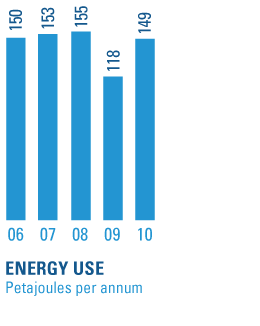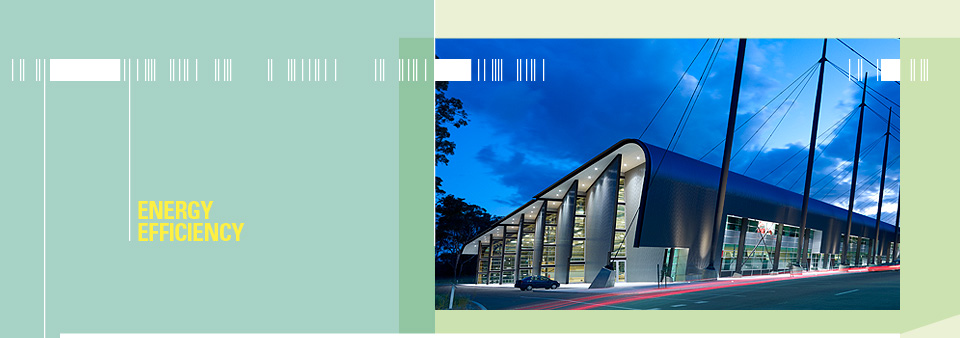

ENERGY EFFICIENCY
Iron and steelmaking consumes large quantities of energy, mainly in the form of coal. More than 80 per cent of this consumption is unavoidable because it is required for the basic chemical reaction in a blast furnace converting iron ore into iron.
Despite this reliance on coal, BlueScope Steel is continuously seeking ways to reduce its energy intensity through improved operational practices and a range of energy efficiency projects. By-product gases generated by steelmaking processes are captured and reused for heating processes, reducing the need to purchase energy externally.
Natural gas (about 10 per cent) and electricity (about 7 per cent) make up the majority of remaining energy use and initiatives to save these commodities have also been implemented across the Company.
Prior to FY2009, energy intensity for the Company globally had remained relatively stable over a number of years, at approximately 22 gigajoules per tonne of raw steel manufactured. During FY2009, with lower production rates and an associated reduction in economies of scale, the Company's energy intensity was higher than historical levels. With production volumes still returning to normal levels during the early part of FY2010, BlueScope Steel's total global energy consumption was slightly lower and energy intensity was slightly higher than historical levels but improved on FY2009. Returning to the energy intensity levels achieved prior to the global financial crisis as soon as practicable remains a focus for the Company.
Energy Efficiency Opportunities
Program
BlueScope Steel is a participant in the Federal Energy Efficiency Opportunities (EEO) program. The program involves detailed assessments of energy use and the identification of potential savings at the Port Kembla Steelworks, Springhill and Western Port sites.
During the year, assessments were completed to schedule on a number of key plant departments that consume a total of 3.2 PetaJoules of energy per year. Energy use assessed included consumption of utilities and liquid fuels. To date over 93% of BlueScope Steel’s Australian energy use has been assessed under the program.
Each savings opportunity identified is required to undergo a thorough technical and financial feasibility assessment to determine its viability. A summary of assessments completed this year is provided in Table (1). Further information on the Energy Efficiency Opportunities program is available on the corporate website: www.bluescopesteel.com
Table 1 - Summary of Projects Identified during Energy Efficiency Opportunities Program Assessments carried out in FY2010
| Site / Plant Assessed | Number of Potential Energy Savings Opportunities Identified by Assessments | Potential Energy Savings < 4yrs* payback GJ/p.a. |
|---|---|---|
| Port Kembla Steelworks Plate Mill | 1 | 17,039 |
| Springhill Works Metal Coating | 5 | 77,444 |
| Western Port Works – Painting | 5 | 184,719 |
* Pending confirmation during feasibility studies

